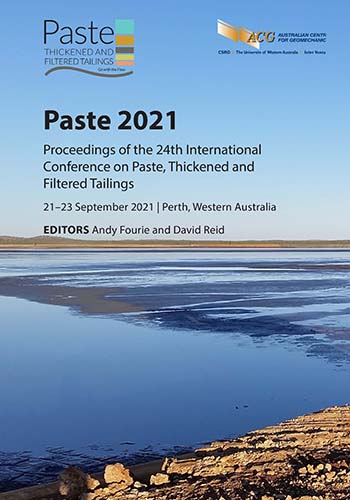The effect of changing grinding cycle on the flow-ability of cemented paste backfill: effect of particle size distribution

|
Authors: Safarizadeh, A; Taheri, A |
DOI https://doi.org/10.36487/ACG_repo/2115_36
Cite As:
Safarizadeh, A & Taheri, A 2021, 'The effect of changing grinding cycle on the flow-ability of cemented paste backfill: effect of particle size distribution', in AB Fourie & D Reid (eds), Paste 2021: Proceedings of the 24th International Conference on Paste, Thickened and Filtered Tailings, Australian Centre for Geomechanics, Perth, pp. 453-460, https://doi.org/10.36487/ACG_repo/2115_36
Abstract:
Cemented paste backfill (CPB) is an engineered design mixture that is commonly implemented to fill the left behind voids of mining. Depending on the sides of the stope under vertical and horizontal exposure, different mixture designs are needed to provide the minimum required strength to continue mining underfilled mass safely. Various parameters affect the strength of CPB and need to be checked daily as CPB quality control. One of the most important of these parameters is the particle size distribution (PSD). One way to increase the recovery of metal is to increase the milling time, which decreases the PSD of tailings significantly. This particle size reduction can undoubtedly change the properties of CPB. This study investigates the effect of changing PSD on both the strength and flow-ability of CPB binary. In this regard, a range of tailings with variations of PSDs from 90% less than 35 µm to 90% more than 35 µm were prepared. P10 and P80 of samples were meticulously obtained and unconfined compressive strength (UCS), slump, and density tests conducted on 52 mm cylinder-shaped samples with a cylinder shape slump coin and with a Marcy scale. The results show that decreasing PSD can have a negative effect on the flow-ability of CPB, but strength first decreased; and then by a further decrease of PSD, strength increased significantly. Outcomes of this research were applied to CSA Mine’s paste mixture due to the changes in the milling circle. Furthermore, the results of this research can be considered for backfill design if the PSD size has exceeded the limitations.
Keywords: paste, particle size distribution, tailings, flow-ability
References:
Bentz, DP 2008, ‘A review of early-age properties of cement-based materials’, Cement and Concrete Research, vol. 38, pp. 196–204.
Belem, T & Benzaazoua, M 2004, ‘An overview on the use of paste backfill technology as a ground support method in cut-and-fill mines’, in E Villaescusa & Y Potvin (eds), Ground Support 2004: Proceedings of the Fifth International Symposium on Ground Support, Taylor & Francis Group, London, pp. 637–650.
Deng, XJ, Klein, B, Hallbom, DJ, de Wit, B & Zhang, JX 2018, ‘Influence of particle size on the basic and time-dependent rheological behaviour of cemented paste backfill’, Journal of Materials Engineering and Performance, vol. 27, pp. 3478–3487.
Helinski, M, Fahey, M & Fourie, A 2011, ‘Behaviour of cemented paste backfill in two mine stopes: measurements and modelling’, Journal of Geotechnical and Geoenvironmental Engineering, vol. 137, issue 2, pp. 171–182.
Kesimal, A, Yilmaz, E, Ercikdi, B, Alp, I & Deveci, H 2005, ‘Effect of properties of tailings and binder on the short-and long-term strength and stability of cemented paste backfill’, Materials Letters, vol. 59, pp. 3703–3709.
© Copyright 2026, Australian Centre for Geomechanics (ACG), The University of Western Australia. All rights reserved.
View copyright/legal information
Please direct any queries or error reports to repository-acg@uwa.edu.au
View copyright/legal information
Please direct any queries or error reports to repository-acg@uwa.edu.au





